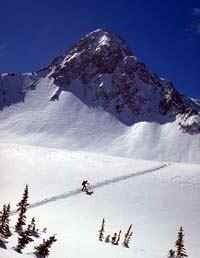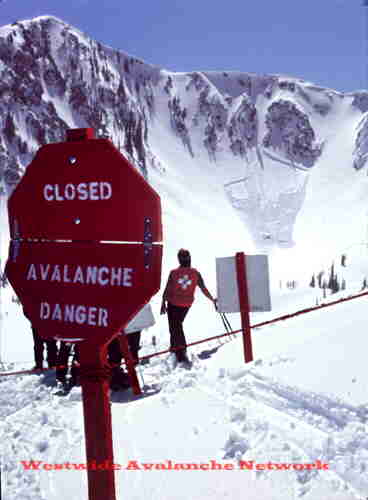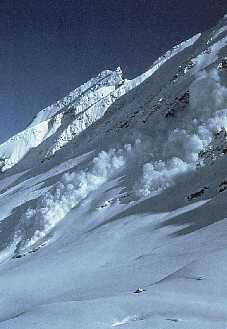|
|
1
|
Steepness. Most avalanches occur on slopes between 35 and 45 degrees.
Slopes less than 30 degrees seldom produce avalanches and slopes steeper
than about 50 degrees sluff so often that they tend not to build up into
slabs. So it's the intermediate slope steepness that produces most of the
avalanches. But the bad news is that exactly the kind of slopes we like to
ski, snowboard or snowmobile usually produce most of the avalanches. A black
diamond slope at a ski resort is usually around 35 degrees--prime steepness
for producing avalanches.
|
2
|
Anchors. Trees and rocks that stick up through the snowpack can help to
hold the snowpack in place. But the anchors need to be quite thick to be
effective. For instance a thick, mature grove of evergreen trees anchor the
slab quite effectively while a sparse grove of aspen trees have very little
effect.
|
3
|
Aspect with respect to wind. Recently wind-loaded, steep slopes are almost
always very dangerous while recently wind-eroded slopes are usually fairly
safe.
|
4
|
Aspect
with respect to sun. In the Northern Hemisphere as temperate
latitudes, the direction a slope faces (aspect) is very important. For
instance, north facing (shady) slopes usually produce more avalanches
and more persistent avalanche hazard in mid winter. On the other hand,
in the spring when wet avalanches occur from strong sun, south facing
slopes produce more wet avalanches. At equatorial or Arctic latitudes,
the aspect with respect to the sun has very little effect.
|
5
|
Consequences.
What will happen to you if the slope slides? It's very difficult to
survive an avalanche if it strains you through thick trees or dumps
you over a large cliff or deposits you into a crevasse or dumps you
into a narrow gully (creating a very deep burial). On the other hand
you have a fairly good chance of survival on a small avalanche path,
without obstacles and a gentle run-out.
|

|
|
Look for obvious
clues
|
- The best sign of avalanches are other avalanches. You can't get much more
obvious than that. But it's surprising how often people miss this clue.
- Collapsing snow. When you hear the snowpack collapse
catastrophically with a giant "whoomph", that's the sound of the
snowpack screaming in your ear that it's extremely unstable. Stay off of
steep slopes and stay out from underneath steep slopes.
- Cracking snow. Recent wind loading, especially, creates cracking snow. The
longer the crack, the more dangerous. Stay off of steep slopes.
- Avalanche weather. Just like people, avalanches do not like RAPID changes.
- Recent rapid loading of new or windblown snow
- Recent rapid warming
- Recent rapid melting
- Rain on new snow
|

|
Active Tests
|
- Use test slopes. Find a small, safe, steep slope and go jump on it to see
how it responds. You can do this on a snowmobile, snowboard, on skis or on
foot.
- Cornice tests. Find a refrigerator-sized cornice and tumble it down the
slope. Hint: ALWAYS wear a belay rope and use a snow saw or thin avalanche
cord to cut the cornice.
- Dig snow pits in representative slopes. You will need to take a reputable
multi-day avalanche class to learn how to effectively do snowpit tests.
|
 |
|
| One at a time. There always needs to be someone left behind to do the
rescue. Someone always needs to remain in a safe place while their friend(s)
are on the dangerous part of the slope. Never put everyone on the slope at
once. With large groups, split them in half and stay in visual and voice
contact.
|
| Have an escape route planned. Always think avalanche. What will you do if
the slope slides. Have a plan first.
|
| Use slope cuts. Keep your speed up and cut across the starting zone, so
that if the slope slides, your momentum can carry you off the moving slab
into safer terrain. You can do this on skis, snowboards or on snowmobiles.
|
 |
Watch out for cornices. They always break farther back than you think.
Always give them a wide berth. NEVER, NEVER walk out to the edge of a
drop-off without first checking it out. Many people have died this way.
|
| If it looks too
dangerous, find a safer alternative. Use terrain to your
advantage. Follow ridges, thick trees and slopes with safer consequences.
You can almost always go back the way you came. The route got you there, it
will most likely get you back as well.
|
| If there's no other choice, go underground. You can almost always weather
out a bad storm or bad avalanche conditions by digging a snow cave or
seeking the shelter of a crevasse. You may be uncomfortable but you will be
alive. |



